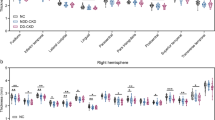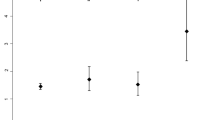Abstract
To investigate the pattern of brain volume changes in patients with end-stage renal disease (ESRD) using voxel-based morphometry (VBM) and correlation with clinical and neuropsychological (NP) tests. Fifty seven ESRD patients with no anatomical abnormalities in conventional magnetic resonance imaging [24 patients with abnormal NP scores, 16 male, 39 ± 12 years; 33 patients with normal NP scores, 23 male, 35 ± 9.7 years] and 22 age- and gender-matched healthy controls (14 male, 36 ± 10.1 years) were recruited in this study. Results from VBM analysis were analyzed with ANOVA test among 3 groups (controls, minimal nephro-encephalopathy group, non-nephro-encephalopathy group). Multiple linear regression analysis was used to investigate the effect of serum urea and creatinine, and dialysis duration on the brain volumes in ESRD patients. Correlation analysis was performed to investigate the association between NP scores with the brain volumes in ESRD patients. Compared with healthy controls, ESRD patients showed diffusely decreased gray matter volume that further decreased in the presence of encephalopathy. Multiple linear regression results showed that serum urea was negatively associated with changes in gray matter volume in many regions, while dialysis duration was negatively associated with some white matter volume changes (All P < 0.05, AlphaSim correction). NP scores correlated with some decreased gray matter volume in ESRD patients (All P < 0.05, AlphaSim correction). No correlation was found between white matter volume and any NP test scores in ESRD patients. This study found predominantly decreased gray matter volume in ESRD patients, which was associated with neurocognitive dysfunction. Serum urea level may be a risk factor for decreased gray matter in ESRD patients.






Similar content being viewed by others
Abbreviations
- DST:
-
Digit symbol test
- ESRD:
-
End-stage renal disease
- GM:
-
Gray matter
- MRI:
-
Magnetic resonance imaging
- NCT-A:
-
Number connecting-A
- VBM:
-
Voxel-based morphometry
- WM:
-
White matter
References
Agildere AM, Kurt A, Yildirim T, Benli S, Altinors N (2001) MRI of neurologic complications in end-stage renal failure patients on hemodialysis: pictorial review. Eur Radiol 11(6):1063–1069
Brouns R, De Deyn PP (2004) Neurological complications in renal failure: a review. Clin Neurol Neurosurg 107(1):1–16
Chiu ML, Li CW, Chang JM, Chiang IC, Ko CH, Chuang HY, Sheu RS, Lee CC, Hsieh TJ (2010) Cerebral metabolic changes in neurologically presymptomatic patients undergoing haemodialysis: in vivo proton MR spectroscopic findings. Eur Radiol 20(6):1502–1507
De Deyn PP, Vanholder R, D’Hooge R (2003) Nitric oxide in uremia: effects of several potentially toxic guanidino compounds. Kidney Int 84(Suppl):S25–S28
De Deyn PP, Vanholder R, Eloot S, Glorieux G (2009) Guanidino compounds as uremic (neuro)toxins. Semin Dial 22(4):340–345
Fazekas G, Fazekas F, Schmidt R, Kapeller P, Offenbacher H, Krejs GJ (1995) Brain MRI findings and cognitive impairment in patients undergoing chronic hemodialysis treatment. J Neurol Sci 134(1–2):83–88
Fazekas G, Fazekas F, Schmidt R, Flooh E, Valetitsch H, Kapeller P, Krejs GJ (1996) Pattern of cerebral blood flow and cognition in patients undergoing chronic haemodialysis treatment. Nucl Med Commun 17(7):603–608
Ferenci P, Lockwood A, Mullen K, Tarter R, Weissenborn K, Blei AT (2002) Hepatic encephalopathy– definition, nomenclature, diagnosis, and quantification: final report of the working party at the 11th World Congresses of Gastroenterology, Vienna, 1998. Hepatology 35(3):716–721
Foley RN, Collins AJ (2007) End-stage renal disease in the United States: an update from the United States Renal Data System. J Am Soc Nephrol 18(10):2644–2648
Galons JP, Trouard T, Gmitro AF, Lien YH (1996) Hemodialysis increases apparent diffusion coefficient of brain water in nephrectomized rats measured by isotropic diffusion-weighted magnetic resonance imaging. J Clin Invest 98(3):750–755
Geissler A, Fründ R, Kohler S, Eichhorn HM, Krämer BK, Feuerbach S (1995) Cerebral metabolite patterns in dialysis patients: evaluation with H-1 MR spectroscopy. Radiology 194(3):693–697
Giang LM, Weiner DE, Agganis BT, Scott T, Sorensen EP, Tighiouart H, Sarnak MJ (2011) Cognitive function and dialysis adequacy: no clear relationship. Am J Nephrol 33(1):33–38
Gotch FA, Sargent JA (1985) A mechanistic analysis of the National Cooperative Dialysis Study (NCDS). Kidney Int 2(3):526–534
Hsieh TJ, Chang JM, Chuang HY, Ko CH, Hsieh ML, Liu GC, Hsu JS (2009) End-stage renal disease: in vivo diffusion-tensor imaging of silent white matter damage. Radiology 252(2):518–525
Kamata T, Hishida A, Takita T, Sawada K, Ikegaya N, Maruyama Y, Miyajima H, Kaneko E (2000) Morphologic abnormalities in the brain of chronically hemodialyzed patients without cerebrovascular disease. Am J Nephrol 20(1):27–31
Kim HS, Park JW, Bai DS, Jeong JY, Hong JH, Son SM, Jang SH (2011) Diffusion tensor imaging findings in neurologically asymptomatic patients with end stage renal disease. NeuroRehabilitation 29(1):111–116
Koushik NS, McArthur SF, Baird AD (2010) Adult chronic kidney disease: neurocognition in chronic renal failure. Neuropsychol Rev 20(1):33–51
Liu JY, Ding J, Lin D, He YF, Dai Z, Chen CZ, Cheng WZ, Wang H, Zhou J, Wang X (2013) T2* MRI of minimal hepatic encephalopathy and cognitive correlates in vivo. J Magn Reson Imaging 37(1):179–186
Madero M, Gul A, Sarnak MJ (2008) Cognitive function in chronic kidney disease. Semin Dial 21(1):29–37
Ni L, Qi R, Zhang LJ, Zhong J, Zheng G, Zhang Z, Zhong Y, Xu Q, Liao W, Jiao Q, Wu X, Fan X, Lu GM (2012) Altered regional homogeneity in the development of minimal hepatic encephalopathy: a resting-state functional MRI study. PLoS One 7(7):e42016
Owen WF Jr, Lew NL, Liu Y, Lowrie EG, Lazarus JM (1993) The urea reduction ratio and serum albumin concentration as predictors of mortality in patients undergoing hemodialysis. N Engl J Med 329(14):1001–1006
Pliskin NH, Yurk HM, Ho LT, Umans JG (1996) Neurocognitive function in chronic hemodialysis patients. Kidney Int 49(5):1435–1440
Prohovnik I, Post J, Uribarri J, Lee H, Sandu O, Langhoff E (2007) Cerebrovascular effects of hemodialysis in chronic kidney disease. J Cereb Blood Flow Metab 27(11):1861–1869
Radić J, Ljutić D, Radić M, Kovaĉić V, Sain M, Curković KD (2010) The possible impact of dialysis modality on cognitive function in chronic dialysis patients. Neth J Med 68(4):153–157
Savazzi GM, Cusmano F, Musini S (2001) Cerebral imaging changes in patients with chronic renal failure treated conservatively or in hemodialysis. Nephron 89(1):31–36
Shima H, Ishimura E, Naganuma T, Yamazaki T, Kobayashi I, Shidara K, Mori K, Takemoto Y, Shoji T, Inaba M, Okamura M, Nakatani T, Nishizawa Y (2010) Cerebral microbleeds in predialysis patients with chronic kidney disease. Nephrol Dial Transplant 25(5):1554–1559
Tryc AB, Alwan G, Bokemeyer M, Goldbecker A, Hecker H, Haubitz M, Weissenborn K (2011) Cerebral metabolic alterations and cognitive dysfunction in chronic kidney disease. Nephrol Dial Transplant 26(8):2635–2641
Yokoyama S, Hirano H, Uomizu K, Kajiya Y, Tajitsu K, Kusumoto K (2005) High incidence of microbleeds in hemodialysis patients detected by T2*-weighted gradient-echo magnetic resonance imaging. Neurol Med Chir (Tokyo) 45(11):556–560
Zhang LJ, Qi R, Zhong J, Xu Q, Zheng G, Lu GM (2012a) The effect of hepatic encephalopathy, hepatic failure, and portosystemic shunt on brain volume of cirrhotic patients: a voxel-based morphometry study. PLoS One 7(8):e42824
Zhang LJ, Zheng G, Zhang L, Zhong J, Wu S, Qi R, Li Q, Wang L, Lu G (2012b) Altered brain functional connectivity in patients with cirrhosis and minimal hepatic encephalopathy: a functional MR imaging study. Radiology 265(2):528–536
Acknowledgments
This work was supported by the grants from the Natural Scientific Foundation of China [Grant NoS. 30700194, 81322020, and 81230032 for Long Jiang Zhang; Grant No. 81101039 fro Gang Zheng] and China Postdoctoral Science Foundation of Jiangsu Province (Grant No. 100283C for Gang Zheng).
Disclosure of Conflicts of Interest
None of the authors has any conflict of interest to disclose.
Author information
Authors and Affiliations
Corresponding authors
Additional information
Drs. Zhang, Wen, and Ni had the equal contribution to this work.
Electronic supplementary material
Below is the link to the electronic supplementary material.
ESM 1
(DOC 173 kb)
Rights and permissions
About this article
Cite this article
Zhang, L.J., Wen, J., Ni, L. et al. Predominant gray matter volume loss in patients with end-stage renal disease: a voxel-based morphometry study. Metab Brain Dis 28, 647–654 (2013). https://doi.org/10.1007/s11011-013-9438-7
Received:
Accepted:
Published:
Issue Date:
DOI: https://doi.org/10.1007/s11011-013-9438-7




